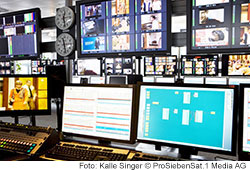Navigatie |
One switch-over that broadcasters welcomeIndustry: Broadcast
|
ChallengeProSiebenSat.1 Produktion refreshes its technical infrastructure at regular intervals to it state of the art. This includes the infrastructure of its control rooms. Recent enhancements have centered on HD compatibility and the introduction of tapeless processes. In connection with these changes, the analog KVM (keyboard, video, mouse) systems in control rooms 7, 8 and 9 have been replaced by new, IP-based devices. Modern KVM technology allows computers and workplaces to be housed at separate locations. This brings far greater flexibility and efficiency to the editing and production processes. Although the computers and servers are located in secure and air-conditioned facilities, they can be controlled directly from the studios and control rooms. "When choosing the new equipment for our control rooms, we looked at the various digital KVM systems available on the market," as Nico Sommer, Senior Systems Engineer for Production Systems at ProSiebenSat.1 Produktion explains. "We eventually opted for one that gave us the necessary flexibility and can be operated using standard infrastructure components – this was the Agility system from Black Box." What's more, due to the latest technology refresh, there were just a few remaining devices capable of supplying exclusively analog video signals. |
SolutionThe Agility is a device for digitally switching, extending and distributing video, audio, serial and USB signals. The device can be used as a point-to-point extension for distances of up to 100 meters, to mirror a source at multiple consoles, and as a matrix switch with any number of users. All that is needed to add another user to the system, is an additional Agility receiver in order to combine digital video, audio and USB from different sources. What's more, the device enables multiple users to share a single remote computer (single target sharing): Three access modes (view-only, share and exclusive) allow a wide range of applications. The system can be controlled and managed from a central location using the iPath controller unit. The convenient on-screen dashboard allows administrators to keep track of transmitters and receivers, define new content channels, manage access rights and configure devices. Furthermore, the VNC host integrated in the transmitter permits remote web access in full HD resolution for maintenance purposes. Workstations in the control room which still had 4:3 displays were the first to be switched over. The other workstations were then gradually converted until all were equipped with 16:9 monitors. The choice of an IP solution proved to be advantageous. Because it could use the existing standard infrastructure, there was no need to lay new cabling – a slow and costly process. The installation currently comprises 83 transmitters, 64 receivers and two controller units (main/backup). An additional receiver was installed for remote access to the KVM system. |
 "Because the new KVM system transmits digital instead of analog signals, our users enjoy a significantly greater image quality and a higher resolution," says Nico Sommer. "What's more, we have no problem using any type of USB device, whether it's a keyboard, mouse or a memory stick." One of the principle advantages of the new system, however, is that it's fast and cost-effective to extend. "If any of our parameters change and we need more or fewer workstations, for example, the system can be easily adapted to the new situation. This adaptability, coupled with an approach based on industry standards, makes for a future-proof system," says Sommer.
"Because the new KVM system transmits digital instead of analog signals, our users enjoy a significantly greater image quality and a higher resolution," says Nico Sommer. "What's more, we have no problem using any type of USB device, whether it's a keyboard, mouse or a memory stick." One of the principle advantages of the new system, however, is that it's fast and cost-effective to extend. "If any of our parameters change and we need more or fewer workstations, for example, the system can be easily adapted to the new situation. This adaptability, coupled with an approach based on industry standards, makes for a future-proof system," says Sommer.
In the near future, the installation will be extended to include another group of buildings, housing an additional equipment room as well as two control rooms and studios. A further system with two additional controller units has been purchased for this expansion, and is currently being installed. This will make it even easier for employees to switch over – but hopefully not to a different station